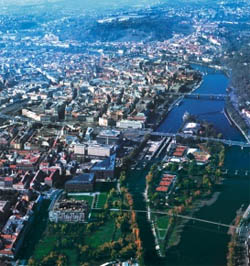
Parcels on Rohanský Island in Prague will be sold for 1.7 billion crowns
 |
Three firms made it to the second round of the bidding process: Development Pobřežní and Avenzo Vice. Development Pobřežní offered 1.59 billion and Avenzo Vice 1.47 billion crowns. The winning bid amounts to 8567 crowns per square meter, the second highest was 8070 crowns and the third 7449 crowns per square meter. The winning Konsorcium Rohan is, according to Aktuálně.cz, owned by the developer Sekyra Group.
According to Poche, the city council must prepare another valuation report according to the committee's recommendations. The current report is about two years old, and there is no current market estimate. In the report available to the committee, the assessed value of the parcels is about half of the winning offer, Reedová pointed out.
The competition concerns approximately 200,000 square meters of land. A new urban center is to be developed on this land, featuring residential buildings, services, hotels, offices, and greenery. A new urban center has already been established, for example, in Smíchov, while another is being built in Pankrác. Among other areas waiting for development are the parcels from heavy industry in Vysočany and the unused plots at Bubny and Žižkov stations.
"The price of 8567 crowns per square meter is, in our opinion, on the lower end. However, we lack sufficient information about potential restrictions, such as environmental burdens, that could lower the land price," said Ondřej Novotný, an analyst at the international consulting firm King Sturge, to CTK.
There were 17 applicants for the bidding process, with the first round assessing the formal requirements of the proposals and urban studies. Three firms that met the criteria and were simultaneously favored by the city development department advanced. They were to submit a price proposal in the second round. This was the most important criterion, while the construction schedule and contractual penalties were weighted much less. The winner will first acquire the land for lease; the city will sell the land only after the constructed buildings have been approved.
According to Novotný, Rohanský Island is the only extensive area in such close proximity to the center that can still be developed. It is highly attractive land, which is why the participation of 17 companies in the first round of the competition is not surprising, he noted. "We consider the proposal for a new urban center, which includes residential buildings, services, a hotel, office spaces, and park greenery, to be adequate. We believe that emphasis should be placed primarily on the long-term and sustainable development of this part of the metropolis," he said.
The sale of part of the island raises concerns among the Green Party. They point out, for example, that the island is not integrated into the public transport system. They argue that a unique opportunity to create a recreational area in the center, similar to Stromovka, will be wasted. However, the Greens are not categorically opposed to new construction. They believe it should be urbanistically considerate with a balanced ratio of built-up and open spaces, and with a well-thought-out public transport system. According to the Greens, the buildings should also be energy-efficient.
Karlín is already preparing for new construction. Previously, flood barriers worth 626 million crowns were completed, and this year the extension of Pobřežní Street to the Libeň Bridge will be finished. This year, the road construction will cost around 90 million crowns. With the assistance of European funds, land will be modified for 182 million crowns, and some old buildings will be demolished.
Rohanský Island is also facing substantial changes. Areas that are not protected by flood barriers will serve as recreation for residents. The city intends to use about 60 hectares of the local land for new greenery, sports, and recreation. The historically filled-in branch of the Vltava River will be restored, and Rohanský and Maninský Islands will be created.
Rohanský Island, along with the entire Karlín area it belongs to, was devastated by a catastrophic flood in August 2002. The district is now protected by barriers against potential recurrence of a natural disaster. Most of the parcels offered by the city in the competition are in the protected part of the island.
The island was formed after 1550 on the site of an old river deposit. During regulation, it was partially connected to the Karlín area and merged with Libeňský Island to the east. The current name is derived from the name of Prague councilor and master carpenter Josef Rohan, who purchased the island in the mid-19th century.
> Three companies compete for parcels on Rohanský Island in Prague [April 23, 2008]
> Councilor: Projects on Rohanský Island will be best assessed by architects [April 7, 2008]
> The commission will discuss offers for the construction of Rohanský Island [February 6, 2008]
> Seventeen interested parties for parcels on Rohanský Island in Prague 8 [September 17, 2008]
> Councilor: Projects on Rohanský Island will be best assessed by architects [April 7, 2008]
> The commission will discuss offers for the construction of Rohanský Island [February 6, 2008]
> Seventeen interested parties for parcels on Rohanský Island in Prague 8 [September 17, 2008]
The English translation is powered by AI tool. Switch to Czech to view the original text source.
0 comments
add comment
Related articles
0
23.05.2018 | Prague 8 approved the study for the construction on Rohanský Island
0
14.03.2018 | Rohanský Island in Prague will transform into a place for recreation
1
14.07.2017 | The Sekyra Group's development on Rohanský Island will be regulated by a study
0
30.05.2016 | On Rohan Island, construction is expected to begin in a year, with drums in the distant future
0
22.04.2014 | Prague will modify Rohanský Island, it will defend against floods











